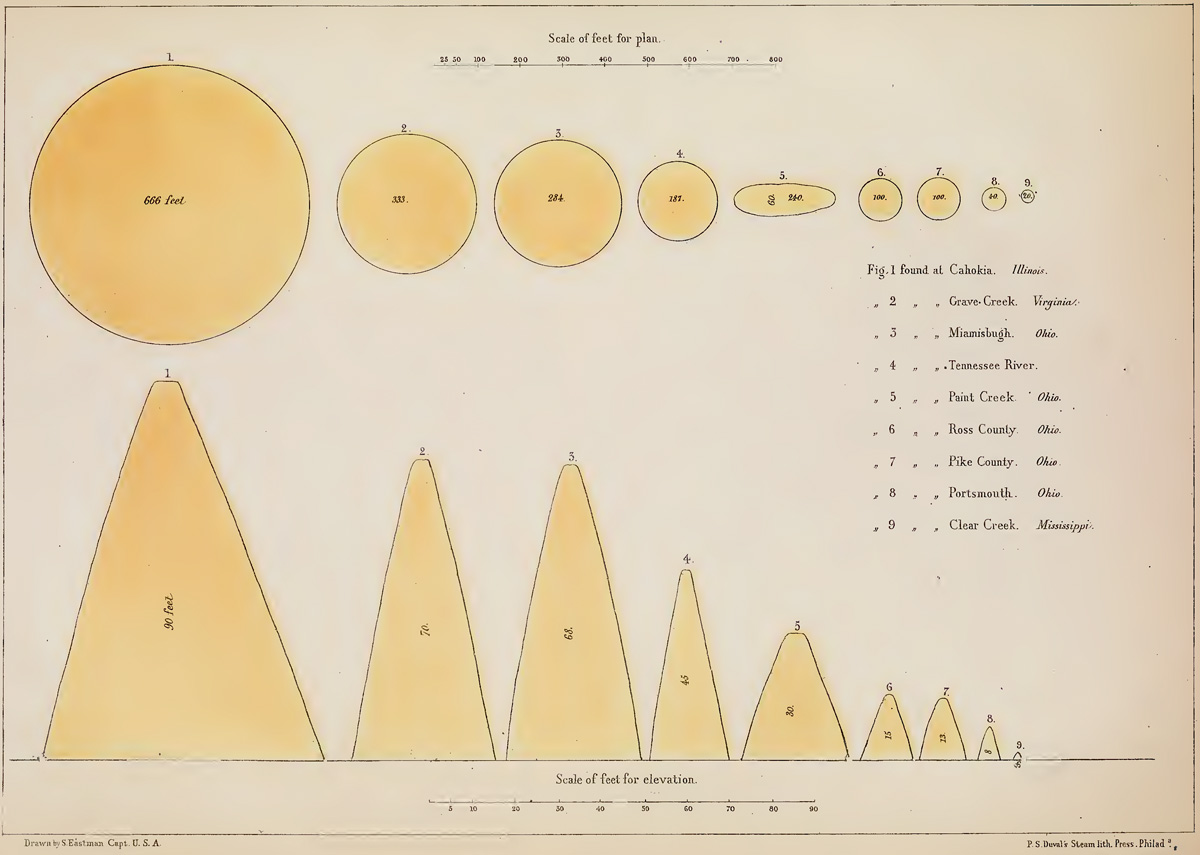While preparing for departure from the Falls of the Ohio, perhaps the local Indian mounds piqued Lewis’s interest. They were described by fellow traveler Thomas Rodney and later by ethnographer Henry Schoolcraft.
In Washington City, Roger Griswold—Representative from Connecticut—raises an objection to the House ratifying the Louisiana Purchase treaty and conventions.
Indian Mounds
A little way south of the Court House and just back of the town is a very large Indian mound. It is by appearance a hundred yards long and sixty yards wide and 20 or 30 feet high. This is much the largest I have seen; and there is a pond near each end of it where the earth was no doubt taken to raise the mound. It is still entire and unbroken.
I went to see the small mound I had noticed yesterday and then in the uper end of the town discovered three more large ones, two of them as large as the one I viewed yesterday but not quite so regular. One of them had a cellar dug for a house on top of it.
—Thomas Rodney (15 and 17 October 1803)[1]Dwight L. Smith and Ray Swick, ed., A Journey Through the West: Thomas Rodney’s 1803 Journal from Delaware to the Mississippi Territory (Athens: Ohio University Press, 1997), 121, 123.
Transcription:
| Location | Circumference (ft) | Elevation (ft) |
|---|---|---|
| Cahokia, Illinois | 666 | 90 |
| Grave Creek, Virginia | 333 | 70 |
| Miamisbugh, Ohio | 234 | 68 |
| Tennessee River | 181 | 45 |
| Paint Creek, Ohio | 60 x 240 | 30 |
| Ross County, Ohio | 100 | 15 |
| Pike County, Ohio | 100 | 13 |
| Portsmouth, Ohio | 40 | 8 |
| Clear Creek, Mississippi | 20 | [3?] |
Representative Griwswold’s Objection
The U.S. House of Representatives resumes the debate on whether to ratify the treaty authorizing the cession of Louisiana. Roger Griswold demands written documentation that the cession from Spain to France has occurred.
It appears in [the Treaty of St. Ildefonso] between Spain and France, Spain stipulated to cede to France, upon certain conditions, the province of Louisiana. The treaty between the United States and the French Government does not ascertain whether these terms have been complied with by France, or whether the cession has been actually made by Spain to France. All that appears is a promise made by Spain to cede. If the terms stipulated by France have not been complied with, and Spain has not delivered the province to France, then it results that France had no title, and of consequence that the United States has acquired no title from France.[3]Annals of Congress, 8th Cong., 1st sess., 385–86 at “A Century of Lawmaking,” Library of Congress, accessed 11 August 2022, … Continue reading
Experience the Lewis and Clark Trail
The Lewis and Clark Trail Experience—our sister site at lewisandclark.travel—connects the world to people and places on the Lewis and Clark Trail.
Plan a trip related to October 24, 1803:

Notes
| ↑1 | Dwight L. Smith and Ray Swick, ed., A Journey Through the West: Thomas Rodney’s 1803 Journal from Delaware to the Mississippi Territory (Athens: Ohio University Press, 1997), 121, 123. |
|---|---|
| ↑2 | Henry R. Schoolcraft, Historical and Statistical Information Respecting the History, Condition and Prospects of the Indian Tribes of the United States (Philadelphia: Lippincott, Grambo & Company, 1851), vol.1, plate 5. |
| ↑3 | Annals of Congress, 8th Cong., 1st sess., 385–86 at “A Century of Lawmaking,” Library of Congress, accessed 11 August 2022, https://memory.loc.gov/cgi-bin/ampage?collId=llac&fileName=013/llac013.db&recNum=190. |

